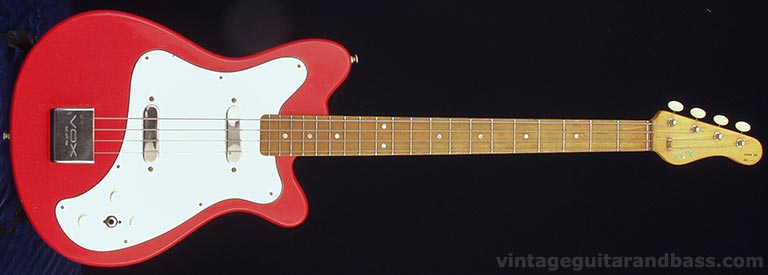
The Vox Clubman bass was a short scale (30"), two-pickup bass, produced in the UK by JMI, primarily for the UK market. It was Vox's least expensive bass model, and sold pretty well to student bassists in the mid 1960s.
It isn't a bad bass, though nothing fancy. The fretboard is flat, unlike the radiused boards of other Vox bass guitars, but it has a comfortable, playable G-plan neck. The board in this example is actually solid sycamore dyed to appear like rosewood. Some earlier examples had a rosewood veneered sycamore board.
Dating this instrument is not difficult; the neck heel is stamped with the date Feb 1965. Furthermore, it has a number of later Clubman features, such as the thicker white escutcheon (scratchplate) with wide black revealed edge, and front mounted output jack. Earlier models had a plain black, plain white, or thinner three-ply (w-b-w) plate, and a side-mounted co-axial output.


The Clubman bass had a May 1965 UK price of £23 2s - compared to £28 7s for the Bassmaster, £89 5s for the Phantom bass and £94 10s for the Symphonic. As these prices suggest, the Clubman and Bassmaster were not of the standard of the Symphonic or Phantom. Although the Bassmaster was slightly more expensive than the Clubman, the latter had a wider neck and was more playable as a result (the Clubman bass had a 1 5/8" width at nut, compared to 1 5/16" for the Bassmaster).
This is a lightweight instrument, at 2.58kg slightly lighter than the Bassmaster (around 3kg) and significantly less than the Symphonic bass (around 4kg).






Typical to early British made Vox's, this bass has the Green Vox logo. The model name and 'JMI Dartford Kt' are on a separate decal - earlier examples had these details combined on one decal. JMI = Jennings Musical Industries, Kt refers to the county of Kent, UK. These decals are never particularly hard wearing, and damaged/incomplete decals are commonplace.
Machine heads are individual open-gear type, with plastic buttons, part number 09-301-0.


The Clubman bass had a one-piece sycamore neck made by a British furniture manufacturer, G-plan, with no adjustable truss rod. The guitars were then assembled in Vox's Dartford plant. Simple open-gear tuning keys like these were used widely by Vox in the early days. Another early feature, only seen in the early British Vox's, is the serial number stamped on the reverse of the headstock (just below the 'E' tuning key); this was the standard location for all UK-produced (JMI) Vox guitars up until early 1966, and on a few models, including the Clubman bass, a little beyond.



The body itself is simple enough - note the rich brown wood (mahogany) of the neck pocket. Earlier examples had a thinner laminate wood body - compare this bass with a 1963 Clubman bass.
The Clubman is a great sounding bass, and despite simple controls (two volumes, and a master tone) it can get a variety of nice tones.
Recorded through a 1964 Ampeg B15N (volume 5/10, treble 5/10, bass 5/10) mic'd with a Shure SM57, into a M-audio mobile pre USB interface.
$950
£499
£354
€555
€555